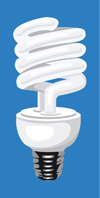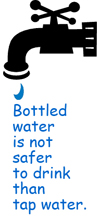
To open a PDF document, you need Adobe Acrobat Reader,Click the icon
follow the prompts. It is free, safe and secure.
|
Sustainability
for All
|
|
Practical
Action for a Fragile Planet
ideas and action on sustainability
from the Dominican Alliance |
 |
| December |
|
REUSE : Don’t Refuse to Reuse
Reuse conserves valuable natural resources. Reuse helps to prevent solid waste from entering landfills and improves our communities.
Reduces the amount of water, air pollution and green house gases.
Reuse redistributes good useful materials to people in need who can still find use in the items.
Reuse limits the need for new natural resources, such as timber, petroleum, fibers and other materials.
Reuse supports local community and social programs while providing donating businesses with tax benefits and reduced disposal fees.
Many reuse centers i.e., St. Vincent dePaul and Goodwill, are engaged in job-training programs, and for the handicapped or at-risk youth programs.
|
|
| November |
|
Stuff? Enough!
If we reduce our buying we save Earth’s resources, lessen ecological damage, decrease production demand, save money, and don’t have to figure out what to do with the item when we are finished with it!
Reduce the need for holiday wrapping paper and ribbon. Use newspapers, magazine pages, cloth, reusable gift bags, yarn or string. If each family just used only 2 feet of ribbon, we would save the 38,000 miles of ribbon produced each holiday season, enough to tie a bow around Earth!
Reduce unwanted catalogs. In 1991 each household received an average of 142 catalogs. If each household canceled 10, it would be equivalent to a stack 2,000 miles high.
Reduce your time in front of the TV. The average American will spend almost two years of life watching commercials alone, all of which are designed to make us unhappy with what we have or haven't got.
Before you purchase anything ask yourself, 1) why do I want this, 2) how often will I use it, 3) what are my alternatives, 4) can I get along without it, 5) what will I do with it when I am finished?
Reducing unwanted mail: call companies’ 1-800 number and ask to be removed. Go to www.catalogchoice.com or www.stopjunkmail.org or www.mcrecycles.org
|
5 Questions
that can reduce
your stuff:
Before you purchase anything ask yourself:
1) why do I want this?
2) how often will I use it?
3) what are my alternatives?
4) can I get along without it?
5) what will I do with it when I am finished? |
| August |
|
Collect native seeds
Protect native breeds
- Seeds are the World’s source of food
and fiber.
- Native strains are more resilient and do not
need petroleum based fertilizers.
- Native strains, because of years of natural
selection are the hardiest and best adapted.
- Native strains are conducive to good health
and are well adapted to their growing regions.
- Native strains conserve plant diversity. (Worldwatch
paper #148 by John Trexiel, Sept 1999.) (loss of plant genetic
diversity is leaving the world vulnerable to multibillion-dollar
crop losses and reduces the store-house from which future agricultural
strains can be derived. p. 61 Vanishing Borders by Hilary French).
- Native strains are stable as a result of selective
breeding as opposed to the instability of GMO’s. (genetically
modified organisms)
References: www.yesmagazine.org/schmeiser
www.yesmagazine.org/foodsystem
VANISHING BORDERS (Protecting the Planet in the Age of Globalization) by Hilary
French. |
| July |
Related Links |
July – Energy
conservation
“In
the night, dim the light” In the night, dim the light!
Lighting accounts for about one quarter of all electricity consumed
in the United States.
Your room is not afraid of the dark; turn off the light when you
leave a room.
The summer sky at night is bright with planetary lights, (stars)
but light pollution in our cities and back yards prevent us from
seeing them!
Use lighting controls; photo cells turn lights on and off in response
to natural light levels: for example: off at dawn;
on at dusk.
Using dimmers can also be good for your living style. Dimmed lights
are softer on your eyes, reduce glare, and are great for creating
calm and peaceful spaces.
Not all CFLs work with dimmers though, so make sure that
the bulb is labeled as dimmable by the manufacturer.
It is worth the effort to find a CFL for your dimmer. Dimmable
CFL bulbs are hands-down more efficient than traditional incandescent
bulbs. They use less electricity, cause less pollution and
last much longer. Plus, when you dim a CFL bulb you save
even more electricity.
So have a romantic dinner tonight and turn the lights down
low! |
www.earthshare.gov
www.ecomii.com
www.edf.org |
| June |
|
Higher
is better, take off your sweater.
Air conditioners use inordinate electricity, emit
carbon dioxide, generate sulfur dioxide, a chief ingredient of
acid rain.
Much of the cost of cooling your home can be saved
by passive cooling
techniques: insulation, reflective
barriers and shading.
Ceiling fans are efficient and use little electricity
(make sure your fan is set to blow downward.)
Programmable thermostats can save by automatically
turning back the
temperature 8 or so hours a day.
Heat generated from within the house can be reduced:
turn off incandescent lights, line dry clothes, air dry dishes,
insulate water heater.
Reduce sources of humidity: vent clothes dryer,
use exhaust fans in kitchen and bathroom, cover pots when cooking. |
Coolexcooling.com
Green Living Ideas
 |
| April |
|
“Change
the bulb, save the globe.”
- 25% of household use of electricity is for lighting.
• One Compact Florescent Light (CFL) can save up
to $30 per year on your electric bill.
• CFL’s are 4x more efficient and last 10x
longer than incandescents
• Light Emitting Diodes (LED) are even more efficient
than CFL’s using even less electricity and lasting 10x
longer than CFL’s.
Some objections about cost, looks, and mercury have been raised.
Here are some facts:
• COST: though CFL’s cost more than
incandescents, they save money in both electricity and long life;
savings to the planet: priceless.
• LOOKS: Early CFL’s were slow to
warm up, sometimes didn’t fit fixtures, gave odd light; NOW:
improved versions come in all color spectrums, a great number of
styles and shapes, some can be dimmed.
• MERCURY: CFL’s do contain a tiny
amount of mercury—1.5-4 mg compared to about 500 mg in an
older thermometer; it is not emitted when the light burns. The
greatest mercury producers in the US are coal-fired power plants;
even if the used bulb is landfilled the net mercury emission compared
to that of a comparable incandescent bulb is 5.6 mg to 1.6 for
a CFL.
LED’s are increasingly being used in household applications.
As the technology improves to produce them more inexpensively,
their durability—they have no filament to break, fractional
use of electricity—many applications are for battery use
now; and light intensity make them the next generation of light
bulbs. |
 |
| March |
|
Bottled
Water
“Don’t be a sap,
drink from the tap.”
Bottled water is not safer to drink than tap water. Recent testing
showed that 10 major bottled brands of water contained a mixture
of 38 different pollutants, including fertilizer, bacteria, Tylenol,
and industrial chemicals. (Environmental Working Group)
The rate of bottled water demand is slowing but still growing.
Americans drink an average of 29.3 gallons per year.
Approximately 1.5 million gallons of oil a year are used to make
plastic water bottles. Transporting these bottles adds thousands
of more gallons of oil, all of which significantly adds to greenhouse
gas emissions.
Bottles are made from recyclable plastic but 90% of them end
up in parks and fields, along roadways, or in landfills (where
it takes 1000s of years to break down). Many that are recycled
end up being shipped to China.
Bottled water is 1000 times more out-of-pocket costly than tap
water. Per gallon: Tap water averages $.0015; filtered $.13,
bottled $1.27.
Bottled water is part of the larger issue of privatization, the
move to make water a commodity rather than recognizing it as
a right. Multinational corporations are purchasing water rights
and selling the bottled water back to those who originally held
rights to the water. |

Natural
Resource
Defense Council
Food
and Water Watch
Lighter
Foot Step |
| February |
|
Don't
Dump Pills They May Cause Ills
Inappropriate disosal of unwanted medicine represent
an emerging concern for the environment and public health.
Waste water treatment plants are not designed to
remove synthetic pollutants like pharmaceuticals.
Flushing old medications down the toilet or drain
allows dangerous chemicals to re-enter our drinking water and the
natural water ways supporting fish and wildlife.
Placing medicines in the garbage is an invitation
to drug addicts and a danger to people who forage for food, children
at play, and pets and wild animals investigating the garbage.
To safely dispose of medications, watch your local newspaper for
community medication collection events and follow their directions.
If no collection site is available, your local pharmacist, doctor’s
office, clinic or nearby hospital may be able to advise you. |
 |
| January |
|
“Lower
is better, put on a sweater.”
Minimize your use of ventilation fans such as bathroom and
kitchen in winter.
Regularly replace air filters
Set back the thermostat when asleep or away.
Do an energy audit
Don't heat areas not regularly used.
Open blinds & curtains on the sunny side. |
|
| December |
|
When
you clean, go green.
Refuse to purchase any anti-bacterial soaps. They destroy good bacteria
as well as harmful and are promoting dangerous levels of antibiotic-resistance
in humans.
The Clean Water Fund, a non-profit organization, estimates the average
American uses 40 lbs of unsafe household cleaners each year. These
toxins end up in our bodies, the air, the soil, the oceans, and in
our own drinking water.
Cleaning agents with chlorine bleach release dioxins into the air
and water stream. Dioxins are the most harmful of manufactured carcinogenic
chemicals. A safe alternative is hydrogen peroxide (3% solution).
There are many resources for mixing your own alternative cleaners,
using inexpensive, healthier choices like white vinegar, borax, washing
soda, salt, and hydrogen peroxide.
One chlorine-free scouring cleanser is Bon Ami. One plant-based soap
(as opposed to most soaps which are petroleum-based) is Dr. Bronners.
Clean & Green by Annie Berthold-Bond |
www.care2.com
Green
Cleaning Network |
| November |
|
Start
a fashion. Make cloth bags a passion.
- Plastic doesn’t biodegrade. Each year Americans “throw
away” 100 billion bags.
- Less than 1% of plastic bags world wide are recycled. Only
0.6% in the U.S.They are made of petroleum or natural gas.
- Huge numbers of birds and marine mammals die from ingesting
or getting caught in them.
- China, South Africa, Ireland are among
several nations instituting taxes or outright banning
their use. San Francisco has banned them in the U.S.
Challenge yourself to go one week without
accumulating
any new plastic bags. |
Worldwatch.org
Plastic
Bag
Recylcing |
| October |
|
Mountain
tops roll. All for the coal.
- Coal is the country’s dirtiest source of electricity
and climate changing greenhouse gases.
- Burning coal puts carbon, mercury, and other pollutants into
the atmosphere, contributing to higher incidences of asthma
in children.
- For every one ton of coal extracted from the mountains, 14
tons of debris are dumped, burying streams and filling the
valleys.
- The cost to the mountain eco systems and local communities
includes the constant noise and shaking of the blasting, denuded
mountainsides, flooding, and tons of toxic slag pools.
- Switching one 100 watt incandescent light bulb to a compact
fluorescent cuts the equivalent of 100 lbs of coal. The
CFL uses 75% less energy and can save you $30-60 dollars over
its lifetime.
Challenge yourself to conserve energy in one new way. |
lovemountains.org
Stop
Mountaintop
Removal
Mountain
Justice
Summer |
| September |
|
Be
cool! Use less fuel!
- Plan trips carefully, combine several errands.
- Use smart driving techniques: slow starts, no sudden braking,
use cruise control, don’t speed.
- Carpool when possible.
- Have your car serviced on a regular basis, keep tires properly
inflated.
- Rid car of unnecessary weight.
- Don’t idle engine for more than a minute, turn it off.
|

websites:
www.ucsusa.org
and click on vehicles
www.care2.com
and click on transportation |
| August |
|
Wherever
you roam, eat close to home.
- Food travels an average of 1500 fossil-fueled miles to reach
our plates.
- Our food purchases consume tremendous amounts of oil to fertilize,
irrigate, harvest, package, ship, and advertise.
- Eat less meat. Switch to vegetables one day per week.
- Join a CSA or support a local farmers market.
- Ask local restaurants and grocers to offer locally grown
foods.
- Read Barbara Kingsolver’s Animal, Vegetable,
Miracle
|

Websites:
www.localharvest.org
sustainabletable.org |
| July |
|
Don’t
feed. Don’t mow. Let grow.
- Over 100 millions pounds of chemicals are dumped on U.S.
lawns each year.
- The US uses over 800,000,000 gallons of gas annually in lawn
mowers.
- Mow only when needed. Set mower height to 3 inches and
return grass clippings to lawn.
- Keep mower blades sharp to prevent harming grass and inviting
disease.
- Plant native grass and flowers, which require less water
and no fertilizer.
- Plant edible landscape instead of grass.
|

Web sites:
Green
Conscience
www.richsoil.com |
| |
|
|











